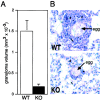T1/ST2-deficient mice demonstrate the importance of T1/ST2 in developing primary T helper cell type 2 responses
- PMID: 10727469
- PMCID: PMC2193113
- DOI: 10.1084/jem.191.6.1069
T1/ST2-deficient mice demonstrate the importance of T1/ST2 in developing primary T helper cell type 2 responses
Abstract
We have generated mice with a deficiency in T1/ST2 expression to clarify the roles of T1/ST2 in T helper cell type 2 (Th2) responses. Using immunological challenges normally characterized by a Th2-like response, we have compared the responses of T1/ST2-deficient mice with those generated by wild-type mice. Using a primary pulmonary granuloma model, induced with Schistosoma mansoni eggs, we demonstrate that granuloma formation, characterized by eosinophil infiltration, is abrogated in T1/ST2-deficient mice. Furthermore, we clearly demonstrate that in the absence of T1/ST2 expression, the levels of Th2 cytokine production are severely impaired after immunization. Thus, in a secondary pulmonary granuloma model, draining lymph node cells from the T1/ST2-deficient animals produced significantly reduced levels of IL-4 and IL-5, despite developing granulomas of a magnitude similar to those of wild-type mice and comparable antigen-specific immunoglobulin isotype production. These data clearly demonstrate that T1/ST2 expression plays a role in the development of Th2-like cytokine responses and indicate that effector functions are inhibited in its absence.
Figures






References
-
- Finkelman F., Shea-Donohue T., Goldhill J., Sullivan C., Morris S., Madden K., Gause W., Urban J. Cytokine regulation of host defence against parasitic gastrointestinal nematodeslessons from studies with rodent models. Annu. Rev. Immunol. 1997;15:505–533. - PubMed
-
- McKenzie G., Bancroft A., Grencis R., McKenzie A. A distinct role for interleukin-13 in Th2-cell-mediated immune responses. Curr. Biol. 1998;8:339–342. - PubMed
-
- Wills-Karp M., Luyimbazi J., Xu X., Schofield B., Neben T.Y., Karp C.L., Donaldson D.D. Interleukin-13central mediator of allergic asthma. Science. 1998;282:2258–2261. - PubMed
-
- Finkelman F., Urban J., Beckmann P., Schooley K., Holmes J., Katona I. Regulation of murine in vivo IgG and IgE responses by a monoclonal anti-IL-4 receptor antibody. Int. Immunol. 1991;3:599–607. - PubMed
Publication types
MeSH terms
Substances
LinkOut - more resources
Full Text Sources
Other Literature Sources
Molecular Biology Databases
Research Materials

